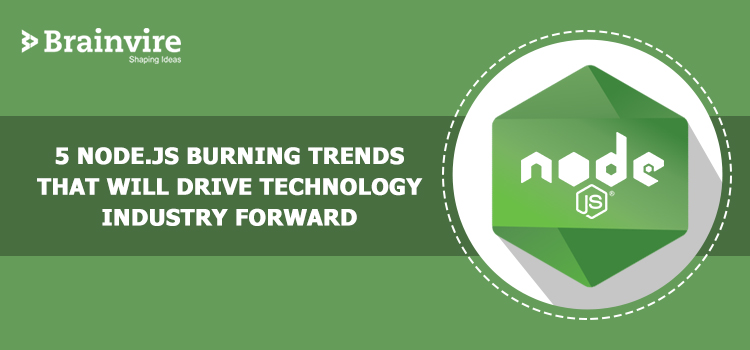Node.js is an open-source cross-platform JavaScript runtime environment. It is based on Google Chrome’s V8 engine used for developing server-side and networking applications. Node.js was launched in 2009 and since then it has been helping developers create fast, flexible, and scalable applications. What’s important to note is that Node.js utilizes an event-driven non-blocking I/O, which makes it a more efficient, lightweight, and popular backend platform.

Most of the Fortune 500 companies and top-notch brands have implemented Node.js in their technology stock. The list includes social media moguls such as Twitter and LinkedIn, eCommerce website development giants such as eBay and Walmart, cab service provider Uber, and American space agency NASA.
We are familiar that Node.js provides a wide spectrum of benefits such as high performance and scalability, easy to learn, used as a single programming language, and more. But we are here to discuss and throw substantial light on the recent trends prevailing in Node.js development. A Node.js developer will only be able to reap the advantages of this platform if he is up-to-date with the latest technology.
Node.js Offers a Serverless Architecture
Have you heard about serverless architecture? If we were to explain serverless architecture in simple language, it is a software pattern where third-party applications host applications. As such, you do not need server software or hardware management.
Thus, having a serverless architecture will mean that you don’t have to bother about managing server applications while they are running. The development team just needs to focus on building software. The serverless architecture also allows you to validate your idea easily and cost-effectively. You can bring more agility to application development.
How Does Serverless Application Help in Business Growth
- It provides the advantage of upfront infrastructure planning.
- It helps in improving code quality by allowing you to use small reusable services.
- It allows you to calculate cost projections more precisely with an enhanced infrastructure return rate.
- You can migrate your projects from DevOps to the development process.
- You can also reuse key features such as authorization and payment process.
We can put forth the example of a renowned soft drink company Coca Cola that used IoT as a serverless architecture. The company collected sales reports from vending machines worldwide, eliminating the usage of servers in the process. The use of serverless architecture allowed the company to curtail its operational costs from $1300 to $4500 a year.
Node.js Has Many Advanced Frameworks
As a node.js developer, you will get the advantage of working with various frameworks; both minimal and full-stack. We can cite a few examples here-
- Express.js
Express.js provides exceptional web API development solutions along with support for various plug-ins. The framework is best for creating simple hybrid web and mobile applications. Thus, it is known as the optimal Node.js framework and will remain in the hunt for 2019 and beyond.
- KOA.js
It is another popular Node.js framework ideally suitable for developing web and API. It also helps to reduce the development time through outstanding error handling and callback activities. It also has best-in-class functionalities and middleware free architecture facilities.
- Meteor.js
Meteor.js is a full-stack Node.js framework that also helps in building mobile and web apps. The developers have to do less coding, which increases the speed and efficiency of the project. You can also integrate it easily with other frameworks. It allows you to reuse the codes.
Besides these, there are some other frameworks as well such as Mean.io and Catberry. However, the client needs to consult an experienced node.js developer to know which framework will perfectly suit the requirements of his project.
Node.js Microservices
Microservices are single self functional units combined with several other units to form a large application. The application gets split into small units and each part can be deployed independently and scalable. Microservices are worth more as technology when you are wanting to build large applications and proven solutions. It helps in improving app maintenance and reduces technological complications.
Let’s highlight the key benefits of Microservices-
- You can employ different teams to work on various aspects of the application together.
- Application parts having an intensive load get scaled to multiple instances. It reduces the cost of scaling. For instance, if most of the app users use video streaming, it will automatically drive traffic to the app.
- It offers faster-decoupled deployments. It is up to the developer to decide whether he wants to release a feature independently or through a major update.
- Several applications can use Microservices and it helps in reducing logic replication.
- If any part of the development process is unsuccessful, it will not affect the entire project.
Cloud Computing
With Node.js you have the leverage to create an entirely new product or upgrade the existing one. Cloud computing lets you use most of the varied application services such as Software-as-a-Service (Prisma, Google Apps), Platform-as-a-Service (Amazon Web Services), and Infrastructure-as-a-Service (Amazon EC2).
Here are a few pros for Cloud Computing
- It allows business enterprises to easily estimate their cost projection.
- It provides high scalability without spending on hardware requirements.
- Since it is cloud-based technology, you can get robust security to protect your applications.
Incorporating Real-Time App Interactions
The applications need to provide real-time interaction to enhance the user experience of the end customers. To boost this communication process, they use various technologies such as chatbots, teleconferencing software, and voice-based assistants.
Node.js will help to streamline the communication process through bi-directional interaction. The server-side framework is making use of Socket.io to provide real-time communication. It comprises of two parts. The first is the client-side library, which allows users to perform various activities. The second part is the server-side library that helps in communication. They both let users use event-based interaction.
To Be Used in IoT Development
The Internet of Things is a hotbed technology that is integrated into all appliances today. It is developed for geo-distributed systems. As Node.js is providing the dual benefits of microservices and cloud computing technology, it is deemed fit for developing IoT-based applications.
The IoT-powered application needs to handle a lot of real-time requests and Node.js plays a pivotal role in streamlining it without any hindrances whatsoever.
Keep Following the Latest Trends
Aside from all these above-mentioned popular trends, the Node.js Development Company should also keep an eye on other updates. You can also use Node.js for building enterprise applications and for deploying GraphQL. So far it has been a progressive journey for Node.js framework and it has developed to become a strong ecosystem with many more advantages and features.
Contact Brainvire For NodeJS Development Services
Related Articles
-
Reasons to Be Addicted to Node.js for Real-Time Application Development
In a society where everything moves so fast- especially technology that becomes obsolete much quicker than we would like to admit- there has been an endless search to create more
-
How is Node.js revolutionizing the Way Apps are Developed?
Node.js is one of the most popular JavaScript technologies of the modern age that is being preferred by both the developers as well as the entrepreneurs for their web development
-
All New Security Level for Node.js to Protect Ecommerce Website
When we are using an open source platform, we have the benefit of enjoying free updates and regular maintenance from the software community. This is not just about the updates



